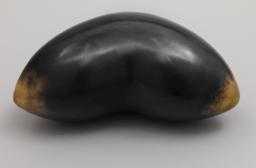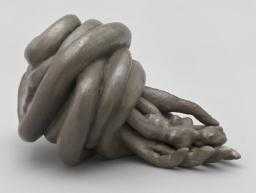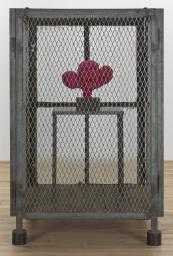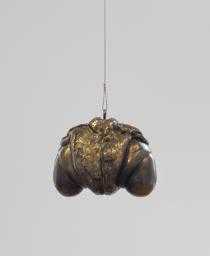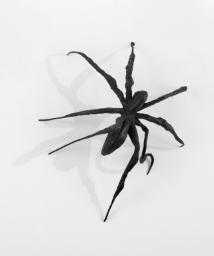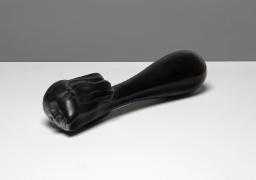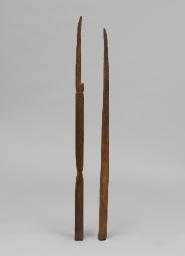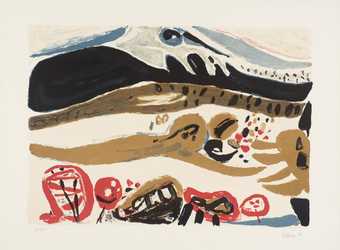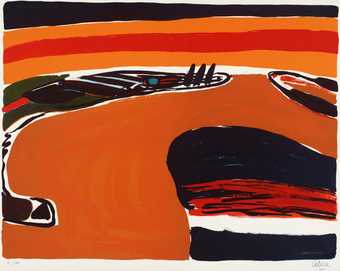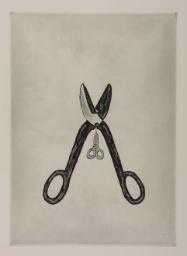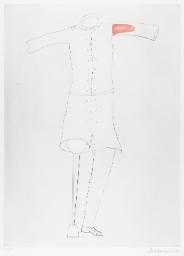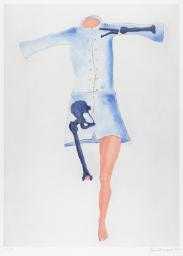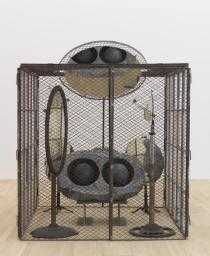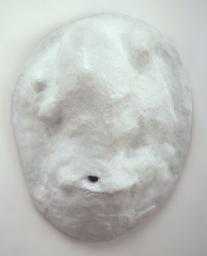
Not on display
- Artist
- Louise Bourgeois 1911–2010
- Medium
- Plaster and latex
- Dimensions
- Unconfirmed: 520 × 1050 × 965 mm
- Collection
- Tate
- Acquisition
- Presented by the artist 2001
- Reference
- T07781
Summary
Avenza is a sculpture consisting of a plaster base supporting a latex cast. It is named after an area of Carrara in Tuscany, Italy, where Bourgeois worked briefly in the late 1960s. She first travelled to Carrara to work with its famous marble in 1967. The form of Avenza was originally created in plaster. From this early version Bourgeois made a version in plastic which was later incorporated into Avenza Revisited 1972 (Robert Miller Gallery, New York) and Avenza Revisited II (Daros Collection). The latex form of Avenza was derived from the original plaster mould and was recast in 1992, since latex decays rapidly when exposed to light and heat. In this form it exists in an edition of six; this is the second in the edition. Bourgeois used an additional latex cast from the same mould to make the multiple-breasted garment she wore in a famous photograph taken in 1975 by Peter Moore. The same piece was used in The Confrontation 1978, an installation and event (Solomon R. Guggenheim Museum, New York). Another important related work, The Destruction of the Father 1974 (Robert Miller Gallery, New York), is an environment of rounded latex breast-like forms of varying sizes that enclose a space from above and below.
In the 1940s and 1950s Bourgeois made pole-like wooden sculptures representing human figures. She began working with plaster, plastic, latex and bronze in the early 1960s. An early precursor to the family of forms to which Avenza belongs is a wooden sculpture titled One and Others 1955 (Whitney Museum of American Art, New York), in which small round-topped cones huddle closely together with taller, more pointed elements. Looking and hiding, aloneness within a group and embattled maternal creativity are themes common to the work Bourgeois was making during this period. Such opposing elements as vulvic openings and phallic growths, vertical forms and horizontal surfaces, soft and hard materials have provided the formal means for Bourgeois to create her own language of emotions and the body. Avenza is a variation on the form which was to become the marble Cumul I (Musée nationale d'art moderne, Centre Georges Pompidou, Paris) the following year. These works are characterised by clustered bulges emerging from drapery, simultaneously connected and separate, evoking instincts and urges from pre-sexual, possibly even pre-natal existence. Bourgeois has written of these works:
They are anthropomorphic and they are landscapes also. Our own body could be
considered, from a topographical point-of-view, a land with mounds and valleys
and caves and holes. So it seems rather evident to me that our own body is a
figuration that appears in mother earth. This is where these landscapes come from.
Technically they are two kinds: there is the poured [latex] landscape that you
actually cannot control, since it is poured; and there is a certain kind of sculptured
and cut landscape, where the landscape is chiselled with a hammer and chisel.
The last landscape I made was a landscape of udders. Well, just picture a female
dog, or a cow; you put her on her back and you have a very interesting, moving,
live and flexible landscape. Everything comes back to that. If you hold a naked
child against your naked breast, it is not the end of softness, it is the beginning of
softness, it is life itself.
(Bourgeois, p.126.)
Further reading:
Louise Bourgeois: Memory and Architecture, exhibition catalogue, Museo Nacional Centro de Arte Reina Sofia, Madrid 1999, reproduced (colour) pl.39
Louise Bourgeois, Marie-Louise Bernadac, Hans-Ulrich Obrist, Destruction of the Father/Reconstruction of the Father: Writings and Interviews 1923-1997, London 1998
Peter Weiermair, Louise Bourgeios, exhibition catalogue, Frankfurter Kunstverein, Frankfurt am Main 1995
Elizabeth Manchester
August 2001
Does this text contain inaccurate information or language that you feel we should improve or change? We would like to hear from you.
Display caption
Avenza belongs to a group of sculptures that Bourgeois made in the late 1960s that are characterised by clustered bulges emerging from drapery, and which evoke organic forms, especially pre-natal forms. Bourgeois has written of these works: ‘They are anthropomorphic and they are landscapes also. Our own body could be considered, from a topographical point-of-view, a land with mounds and valleys and caves and holes.’ The title refers to an area of Carrara in Italy, where Bourgeois worked briefly in the late 1960s.
Gallery label, November 2005
Does this text contain inaccurate information or language that you feel we should improve or change? We would like to hear from you.
Explore
- abstraction(8,615)
-
- from recognisable sources(3,634)
- non-representational(6,161)
-
- irregular forms(2,007)
- body(4,878)
-
- sexual organs(178)
- cities, towns, villages (non-UK)(13,323)
-
- Avenza(3)
- Italy(4,473)
You might like
-
Louise Bourgeois Tits
1967 -
Louise Bourgeois Nature Study
1986 -
Louise Bourgeois Cell XIV (Portrait)
2000 -
Louise Bourgeois Janus Fleuri
1968 -
Louise Bourgeois Spider I
1995 -
Louise Bourgeois Fallen Woman
1981 -
Louise Bourgeois KNIFE COUPLE
1949 -
Pierre Celice White Landscape
1968–9 -
Pierre Celice Untitled - Orange
1972 -
Louise Bourgeois Scissors
1994 -
Louise Bourgeois Amputee with Peg Leg
1998 -
Louise Bourgeois Blue Dress
1998 -
Louise Bourgeois Cell (Eyes and Mirrors)
1989–93 -
Louise Bourgeois Amoeba
1963–5, cast 1984 -
Louise Bourgeois Mamelles
1991, cast 2001

